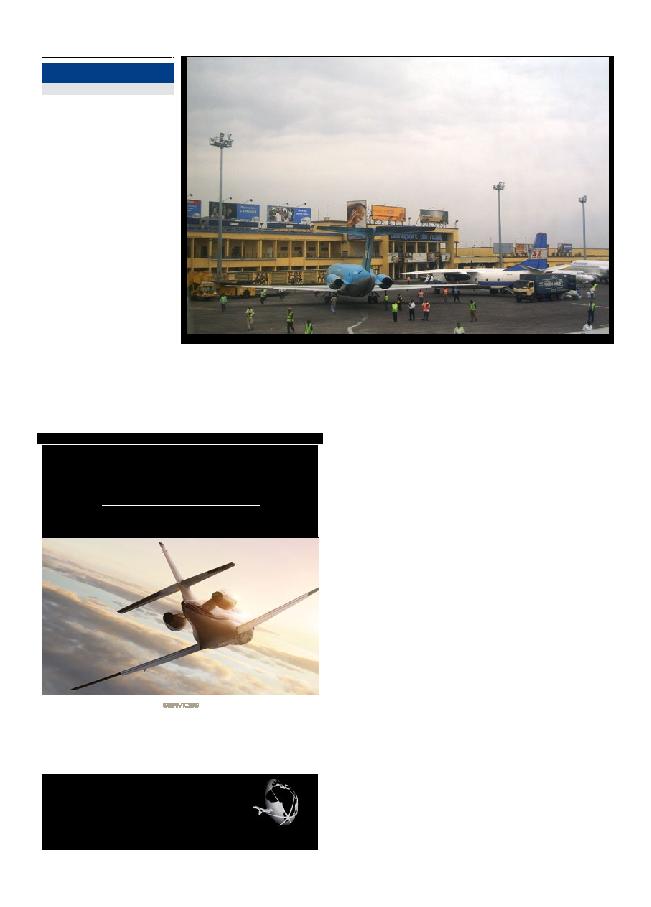
10
GA
/ Vol. 5 / No.9 / SEPTEMBER 2013
by Charmaine de Villiers
Airline News
International Flight Clearances
ServICeS
Arranging Overflight and Landing Clearances
Cost estimates for airport taxes
Fuel availability and pricing
Arrangement of ground handling along routing
Flight following
Departure lounge at Lanseria
Ground handling at Lanseria
Charter Services
International Flight Clearances
International Flight
Clearances
Africa's aircraft handling and
clearance company
International Flight Clearances
Tel:
+27 11 701 2330 (24 hours)
Mobile:
+27 76 983 1089 (24 Hours)
Fax:
+27 11 701 2334
email:
flightops@flyifc.co.za
Website:
www.flyifc.co.za
Address:
Hanger 201, Gate 7 ring road,
Lanersia Airport. We are located in the Lanseria
Jet Centre Offices.
GPS coordinates:
S 25 57.07 e 27 58.1
How safe is it to
fly in Africa?
Many African countries are
experiencing an upward trend in
their economies, often as a result
of increased mining operations,
and with great distances to be
covered to locations there has
been a corresponding demand
for increased air transportation.
Just how safe aviation is
on the 'dark' continent depends
on a number of factors.
Certain countries north of
the Sahara, such as Morocco
and Egypt, generally adhere to
European standards and their
airports, while perhaps not quite
up to Dubai, Hong Kong or other
international airport standards,
are equipped with all necessary
infrastructure. For the rest of the
continent, South Africa, Kenya
and Ethiopia provide passengers
with flight safety, airport security
and the youngest fleets in Africa
with Ethiopia now flying the
Dreamliner, Kenya uses B777
and Embraer E190 together with
several other Boeing aircraft while
SAA has just taken delivery of two
new Airbus A-320s. Botswana and
Namibia have international airports
that are of a reasonable standard.
With some exceptions such as
Rwanda, Uganda and Tanzania
central Africa should be avoided
where possible. The European
Union has in fact banned airlines
from Gabon, Ghana, Angola,
Sierra Leone, Sudan, Mozambique,
Liberia and the Democratic
Republic of Congo, amongst others
from operating into Europe.
Reports from IATA and aviation
experts indicate that safety for
commercial airlines has improved
over the past seven or so years
although accidents do happen.
Nigeria, for example, hasn't seen
any serious incidents involving
large commercial aircraft in recent
years. During 2005 and 2006 the
country suffered three high profile
crashes that killed hundreds,
including the Sultan of Sokoto,
Alhaji Muhammadu Maccido.
The federal government
responded by replacing some
obsolete equipment at four of
Nigeria's major airports and the
country has since not experienced
any air disaster at these major hubs.
On a positive note, when the
number of accidents is measured
against the increased number
of flights, it is obvious that the
accident and fatality rate has
improved dramatically. Some
years ago IATA implemented
the Operational Safety Audit
(IOSA) program and this has
led to a number of countries
using this as part of their
regulatory requirements.
The need for charter
The only way to reach many
business, mining and construction
sites in Africa is via private plane
and it is therefore no surprise
that air charter has become an
essential tool for the serious
business traveller, providing safety,
convenience and flexibility. Due
to political and historical reasons,
airline travel in Africa is usually
to international airports making it
very difficult to go directly from
point to point. Regional flights go
to large cities with no real means
of traveling to any other point
thus air charter is on the increase.
It is however essential to
find a charter operator with an
unimpeachable safety record and
the experience and skill to smooth
out logistical or bureaucratic
problems. It is always a good idea
to have someone on the ground
that can negotiate with local
authorities according to Miles
van der Molen, CEO of CemAir,
whose aircraft are frequently
flying in the hot sports of Central
Africa doing contract work for the
UN and charity organisations.
Safety
Major problems encountered in
many countries are the lack of
infrastructure and maintenance
of the airports. Fire-fighting
equipment, beacons, fuel pumps
and other basic necessities are often
not working or simply don't exist.
Avgas is very seldom available
and most operators would be wise
to ferry their own supply to the
destination. Fuel tanks need to be
carefully checked as fuel is often
rather dirty. Jet A1 is generally
obtainable in most areas and while
Kinshasa International Airport, also
known as N'Djili International Airport
after the nearby Ndjili River, is the larg-
est of the four international airports in
the Democratic Republic of the Congo.
The airport has seen very little mainte-
nance or upgrade and is still using the
infrastructure built by the Belgians dur-
ing the colonial era. -
pic Wikipedia

